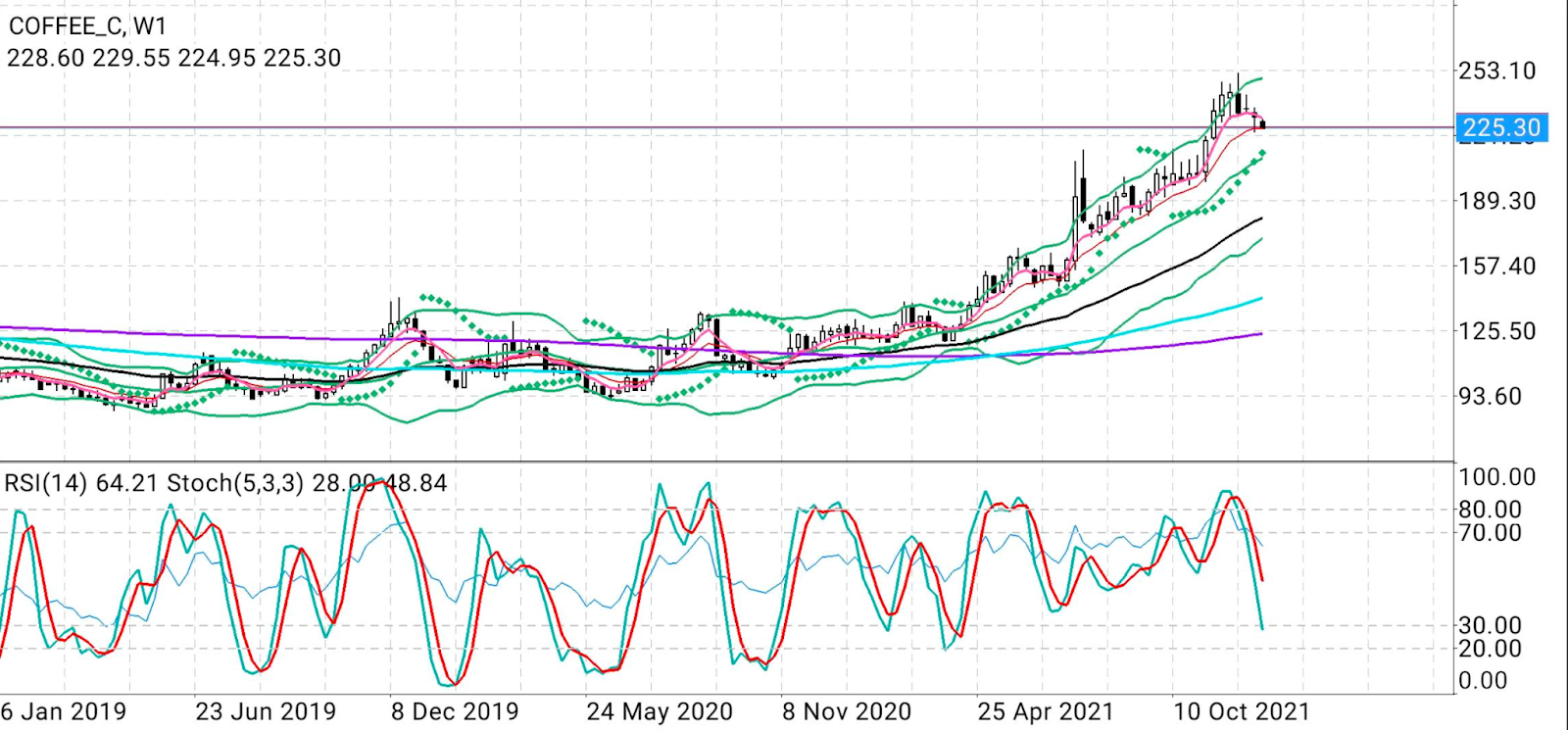Will Coffee’s Mega Rally Continue Into 2022?
That arabica coffee is the biggest winner among major crop commodities for 2021 is beyond dispute. Whether those fortunes will continue well into the new year is what investors need to ascertain.
For now, arabica’s fundamentals indicate that there’s little in the way of the rally, although technicals suggest some correction.

All charts courtesy of skcharting.com
As the year draws to a close, arabica’s front-month March contract on ICE Futures US hovers above $2.25 per lb, about 10% below the 10-year high of above $2.50 set on Dec. 6. For the year, arabica is up more than 75%.
Robusta , the world’s second major coffee variant grown largely in Vietnam, was also off decade-highs hit earlier this month, with a 71% gain on the year.
Coffee has consistently posted the largest gain this year among major crop commodities such as corn , which is up 25%; sugar (23%), wheat (22%), orange juice (13%), soybeans (4%) and cocoa (-5%).
To Know Why Coffee Might Rally Further, We Need To Know Its Fundamentals
The mega rally in coffee is due to multiple factors, not least among them supply.
The coffee market as a whole swung from a surplus to a deficit this year of 5.2 million bags, according to Rabobank analysis reported by Fortune. Other factors include shipping constraints and container shortages, analysts said—and so, unable to know with certainty when and how coffee would be transported, buyers likely overbought, fueling a cycle of panic buying.
According to analysts:
“While production was relatively unaffected by COVID and there is still uncertainty about any potential demand growth in 2021, we believe sales of green coffee have been faring better than expected because coffee was directly impacted by the scarcity of container availability in 2021, leading companies to over-purchase in order to guarantee production and sales.”
Rabobank predicted that the “panic buying” would stop after Christmas, but the wild card is the weather in Brazil, which is the largest producer of the arabica bean. Brazil was hit by both dry weather and frost this past season.
Ole Hansen, head of commodity strategy at Saxo Bank, told CNBC earlier this month that over the past 12 months, “a perfect storm of events [has been] conspiring to give our beloved bean a boost. “The question for future price action is how much of these developments are potentially longer-lasting,” Hansen said.
“I think we need to focus on what’s been unfolding in Brazil this year, where we’ve had a generational low in temperatures, a very quick spell of frost which hit some of the growing areas, and we’ve had a period of drought – this has left the 2022 crop in a bit of a precarious state.”
Hansen added that these adverse weather events would affect the yield later this year, as well as in 2022 and potentially even 2023. “We saw coffee rally to about $3 per pound back in 2011, when we had another Brazil scare,” he said.
“These are really the kind of numbers that prompt the market to speculate whether we can reach those levels once again, and I think with Brazil in mind, and if the projections over the coming months continue to confirm a slowdown or reduction in output, then the risk of our brew getting more expensive is very real.
“I think on balance we have a market which is, for the first time in years, starting to show some tightness.”
Maximillian Copestake, executive director of European coffee sales at Marex, told CNBC in a separate interview that coffee was engaged in “a huge price race that is predominantly driven by freight dislocations.”
“For the last five to eight years, we’ve had supply [concentrated in] one or two big coffee-producing origins, one of them being Brazil, one of them being Vietnam,” Copestake said.
He added:
“If you have damage in one or two of those countries, which we have had, all of a sudden the market goes crazy to try and encourage other countries to produce coffee. That is the underlying principle, and then the cherry on the top has really been the freight disruptions. So, what was already a tight balance sheet, which should have traded out in the prices rallying potentially later on in the crop, have been accentuated by these freight disruptions we’ve seen.”
Copestake also noted that it takes around two years for coffee production to respond to a change in price. “I don’t think we’re by any means out of the woods yet,” he said.
“But when the price rallies, you drag every bag of coffee available in every farmer’s warehouse out to the market to commercialize, because the prices are excellent. So there is incentivization to plant more, but also to minimize stocks at origin and bring those stocks to destination. I think we’re probably in the course of doing that.”
He added that he expects prices to remain high, or at least volatile, looking ahead.
So, What Do Coffee’s Technicals Say?

Sunil Kumar Dixit, chief technical strategist at skcharting.com, notes that arabica has been trading in a $2.35 - $2.23 range with a bearish bias since its early profit-taking on its 10-year high above $2.52.
Going into January 2022, arabica’s bearish Stochastic positioning of 28 - 48 on its weekly chart was well below the Relative Strength Index of 64. This did not promise an immediate resumption of the rally that took it to the $2.52 high without some correction first, said Dixit.
“Broadly speaking, breaking above $2.35 can see arabica resume its uptrend to retest the $2.50 areas,” he said. “Taking on $2.52 is also required to enter the next bullish zone of $2.64 - $2.90 in the January to March 2022 stretch.”
“But weakness below $2.23 can extend arabica’s correction to the $2.15 - $1.90 levels. That should also be remembered.”
Disclaimer: Barani Krishnan uses a range of views outside his own to bring diversity to his analysis of any market. For neutrality, he sometimes presents contrarian views and market variables. He does not hold a position in the commodities and securities he writes about.





Drop an image here or Supported formats: *.jpg, *.png, *.gif up to 5mb
Drop an image here or